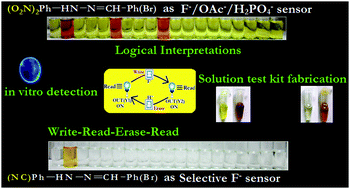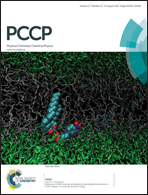Colorimetric and fluorimetric response of Schiff base molecules towards fluoride anion, solution test kit fabrication, logical interpretations and DFT-D3 study†
Abstract
Two newly synthesized Schiff base molecules are herein reported as anion sensors. –NO2 substituted receptor (P1) is comparatively more acidic and can sense F−, OAc− and H2PO4−, whereas –CN substituted receptor (P2) is less acidic and is selective for F− only. Reversible UV-Vis response for both receptors with F− can mimic multiple logic gate functions, and several complex electronic circuits based on XNOR, XOR, OR, AND, NOT and NOR logic operations with ‘Write–Read–Erase–Read’ options have been executed. Interesting ‘turn on and off’ fluorescence responses were noticed for the receptors with F−. Intracellular F− detection as a diagnosis of non-skeletal fluorosis was successful using a fluorescence microscope with Candida albicans (prokaryotic cell, a diploid fungus) and pollen grains of Tecoma stans (eukaryotic cell) incubated in 10−6 M fluoride-contaminated hand-pump water collected from Bankura, West Bengal, India. Furthermore, a solution test kit was fabricated for easy and selective detection of F− in an aqueous solvent.


 Please wait while we load your content...
Please wait while we load your content...